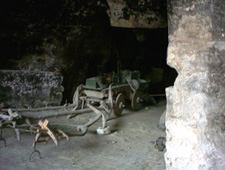 In Rosolini, NOBILE the name is not tied only to a centennial production d 'oil d' olive high quality is often associated to a major archaeological ricadente property in the family. This is a Christian basilica of the IV-V cent. d.C. of great historical value. Given the vastness of the scale, is the greatest monument of its kind existing in Sicily, we realize that it is a real pearl archaeological. Of this important monument ipogeico archaeologists have a total of renowned international reputation, P. Bears to A. Messina to L. Lamb. In the heart of 'old feudal village, through the portal seventeenth century, whose image is the logo of' label on bottles of 'oil, accessing the courtyard of the Palace Platamone.
In Rosolini, NOBILE the name is not tied only to a centennial production d 'oil d' olive high quality is often associated to a major archaeological ricadente property in the family. This is a Christian basilica of the IV-V cent. d.C. of great historical value. Given the vastness of the scale, is the greatest monument of its kind existing in Sicily, we realize that it is a real pearl archaeological. Of this important monument ipogeico archaeologists have a total of renowned international reputation, P. Bears to A. Messina to L. Lamb. In the heart of 'old feudal village, through the portal seventeenth century, whose image is the logo of' label on bottles of 'oil, accessing the courtyard of the Palace Platamone.
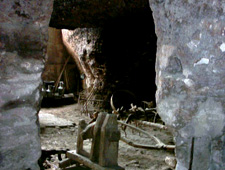 This portal flanked by the bell tower, belonged to the summer residence of feudal lords, the family that obtained in 1712 the 'authorization to build the city with the consent of the authorities netine. Now Platamone the palace, located on the clifftop, remains almost nothing.
This portal flanked by the bell tower, belonged to the summer residence of feudal lords, the family that obtained in 1712 the 'authorization to build the city with the consent of the authorities netine. Now Platamone the palace, located on the clifftop, remains almost nothing.
In 'large courtyard, however, right in front of' oil mill where it produces the 'excellent oil d' olive and under the clifftop,
Portal of seventeenth-century Palazzo Platamone (property 'of' Corporate Nobile) which is the logo of 'label on bottles of' Extra Olive Oil "Nobile."
we find the beautiful church rock of exceptional value. Entirely dug into the rock, the Byzantine basilica shows visitors still in the original structure, although no longer supplements. Some existing hypogea Death, obtained in limestone, have given rise to 'whole plant basilica with three aisles. We note here and the 'inaccuracies and uncertainties architectural precisely due to the need to establish the church on what already existed; of nave in the right retain, in fact, still some arcosolii of Byzantine era.
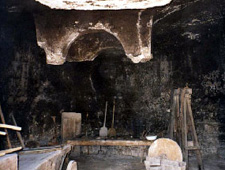 The three aisles of the basilica are bounded by eight spans of arches that are based on massive square pillars which give majesty of the monument. The nave ends with a 'broad apse el' last span separates from the left by a 'blind arch, which allows the isolation of a room irregularly shaped square. At the center of the ceiling of such a vain tegurrina sovrastava all 'originally a tomb monument too' it square in shape. Of this canopy remain only attacks upper piastrini linked by small arches, which surround a semi cupoletta leading to the centre a ring made from stone. On the wall of the left, at the Cenotaph alleged probably erected in memory of a venerable character of the local Church is a niche where certainly was resting l 'need for the celebration of religious rites. Small niches spread, with regularity, on the whole 'environment basilica, suggest that they were used as shelves for lamps.
The three aisles of the basilica are bounded by eight spans of arches that are based on massive square pillars which give majesty of the monument. The nave ends with a 'broad apse el' last span separates from the left by a 'blind arch, which allows the isolation of a room irregularly shaped square. At the center of the ceiling of such a vain tegurrina sovrastava all 'originally a tomb monument too' it square in shape. Of this canopy remain only attacks upper piastrini linked by small arches, which surround a semi cupoletta leading to the centre a ring made from stone. On the wall of the left, at the Cenotaph alleged probably erected in memory of a venerable character of the local Church is a niche where certainly was resting l 'need for the celebration of religious rites. Small niches spread, with regularity, on the whole 'environment basilica, suggest that they were used as shelves for lamps.
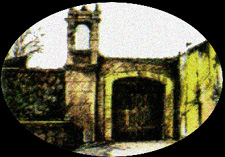 There is still a mystery "who" has designed and constructed this monument. It is assumed that the architectural and religious influences array Eastern Europe, it realized, would be of Syrian-Palestinian origin, brought by one of many monastic communities who came from the Near East in southern Italy and in the territory of future Rosolini. By 'arrival of the Arabs, this place was so suggestive called, is a church, "GARU AS-SALIBIN" (pronounced Rusalibin), or "THE CAVE OF THE CROSS".
There is still a mystery "who" has designed and constructed this monument. It is assumed that the architectural and religious influences array Eastern Europe, it realized, would be of Syrian-Palestinian origin, brought by one of many monastic communities who came from the Near East in southern Italy and in the territory of future Rosolini. By 'arrival of the Arabs, this place was so suggestive called, is a church, "GARU AS-SALIBIN" (pronounced Rusalibin), or "THE CAVE OF THE CROSS".
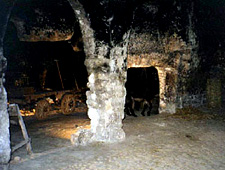 Over time the case was transformed into "RUSALINI" dialect form of 'current ROSOLINI, giving the final name to' whole village that in the meantime it was forming. Today, from Rosolini and from this courtyard pregnant history l 'OIL NOBILE reaches, apprezzatissimo, the most distant destinations. The basilica, cultural pregevolissimo, not only remains to the family that keeps Nobile, such as' oil does not belong only to those who produce. It is a document of great historic archaeological importance. The oil of Nobile, healthy food with special nutritional requirements, together with a wealth of it all.
Over time the case was transformed into "RUSALINI" dialect form of 'current ROSOLINI, giving the final name to' whole village that in the meantime it was forming. Today, from Rosolini and from this courtyard pregnant history l 'OIL NOBILE reaches, apprezzatissimo, the most distant destinations. The basilica, cultural pregevolissimo, not only remains to the family that keeps Nobile, such as' oil does not belong only to those who produce. It is a document of great historic archaeological importance. The oil of Nobile, healthy food with special nutritional requirements, together with a wealth of it all.
Prof. Piero Meli
Coordinatore Gruppo di Studio "LE TIMPE" Rosolini
 In Rosolini, NOBILE the name is not tied only to a centennial production d 'oil d' olive high quality is often associated to a major archaeological ricadente property in the family. This is a Christian basilica of the IV-V cent. d.C. of great historical value. Given the vastness of the scale, is the greatest monument of its kind existing in Sicily, we realize that it is a real pearl archaeological. Of this important monument ipogeico archaeologists have a total of renowned international reputation, P. Bears to A. Messina to L. Lamb. In the heart of 'old feudal village, through the portal seventeenth century, whose image is the logo of' label on bottles of 'oil, accessing the courtyard of the Palace Platamone.
In Rosolini, NOBILE the name is not tied only to a centennial production d 'oil d' olive high quality is often associated to a major archaeological ricadente property in the family. This is a Christian basilica of the IV-V cent. d.C. of great historical value. Given the vastness of the scale, is the greatest monument of its kind existing in Sicily, we realize that it is a real pearl archaeological. Of this important monument ipogeico archaeologists have a total of renowned international reputation, P. Bears to A. Messina to L. Lamb. In the heart of 'old feudal village, through the portal seventeenth century, whose image is the logo of' label on bottles of 'oil, accessing the courtyard of the Palace Platamone.  This portal flanked by the bell tower, belonged to the summer residence of feudal lords, the family that obtained in 1712 the 'authorization to build the city with the consent of the authorities netine. Now Platamone the palace, located on the clifftop, remains almost nothing.
This portal flanked by the bell tower, belonged to the summer residence of feudal lords, the family that obtained in 1712 the 'authorization to build the city with the consent of the authorities netine. Now Platamone the palace, located on the clifftop, remains almost nothing.  The three aisles of the basilica are bounded by eight spans of arches that are based on massive square pillars which give majesty of the monument. The nave ends with a 'broad apse el' last span separates from the left by a 'blind arch, which allows the isolation of a room irregularly shaped square. At the center of the ceiling of such a vain tegurrina sovrastava all 'originally a tomb monument too' it square in shape. Of this canopy remain only attacks upper piastrini linked by small arches, which surround a semi cupoletta leading to the centre a ring made from stone. On the wall of the left, at the Cenotaph alleged probably erected in memory of a venerable character of the local Church is a niche where certainly was resting l 'need for the celebration of religious rites. Small niches spread, with regularity, on the whole 'environment basilica, suggest that they were used as shelves for lamps.
The three aisles of the basilica are bounded by eight spans of arches that are based on massive square pillars which give majesty of the monument. The nave ends with a 'broad apse el' last span separates from the left by a 'blind arch, which allows the isolation of a room irregularly shaped square. At the center of the ceiling of such a vain tegurrina sovrastava all 'originally a tomb monument too' it square in shape. Of this canopy remain only attacks upper piastrini linked by small arches, which surround a semi cupoletta leading to the centre a ring made from stone. On the wall of the left, at the Cenotaph alleged probably erected in memory of a venerable character of the local Church is a niche where certainly was resting l 'need for the celebration of religious rites. Small niches spread, with regularity, on the whole 'environment basilica, suggest that they were used as shelves for lamps.  There is still a mystery "who" has designed and constructed this monument. It is assumed that the architectural and religious influences array Eastern Europe, it realized, would be of Syrian-Palestinian origin, brought by one of many monastic communities who came from the Near East in southern Italy and in the territory of future Rosolini. By 'arrival of the Arabs, this place was so suggestive called, is a church, "GARU AS-SALIBIN" (pronounced Rusalibin), or "THE CAVE OF THE CROSS".
There is still a mystery "who" has designed and constructed this monument. It is assumed that the architectural and religious influences array Eastern Europe, it realized, would be of Syrian-Palestinian origin, brought by one of many monastic communities who came from the Near East in southern Italy and in the territory of future Rosolini. By 'arrival of the Arabs, this place was so suggestive called, is a church, "GARU AS-SALIBIN" (pronounced Rusalibin), or "THE CAVE OF THE CROSS".  Over time the case was transformed into "RUSALINI" dialect form of 'current ROSOLINI, giving the final name to' whole village that in the meantime it was forming. Today, from Rosolini and from this courtyard pregnant history l 'OIL NOBILE reaches, apprezzatissimo, the most distant destinations. The basilica, cultural pregevolissimo, not only remains to the family that keeps Nobile, such as' oil does not belong only to those who produce. It is a document of great historic archaeological importance. The oil of Nobile, healthy food with special nutritional requirements, together with a wealth of it all.
Over time the case was transformed into "RUSALINI" dialect form of 'current ROSOLINI, giving the final name to' whole village that in the meantime it was forming. Today, from Rosolini and from this courtyard pregnant history l 'OIL NOBILE reaches, apprezzatissimo, the most distant destinations. The basilica, cultural pregevolissimo, not only remains to the family that keeps Nobile, such as' oil does not belong only to those who produce. It is a document of great historic archaeological importance. The oil of Nobile, healthy food with special nutritional requirements, together with a wealth of it all.